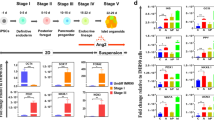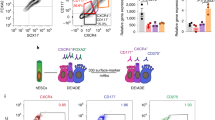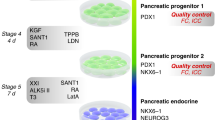Abstract
Nuclear reprogramming of somatic tissue enables derivation of induced pluripotent stem (iPS) cells from an autologous, non-embryonic origin. The purpose of this study was to establish efficient protocols for lineage specification of human iPS cells into functional glucose-responsive, insulin-producing progeny. We generated human iPS cells, which were then guided with recombinant growth factors that mimic the essential signaling for pancreatic development. Reprogrammed with four stemness factors, human fibroblasts were here converted into authentic iPS cells. Under feeder-free conditions, fate specification was initiated with activin A and Wnt3a that triggered engagement into definitive endoderm, followed by priming with fibroblast growth factor 10 (FGF10) and KAAD-cyclopamine. Addition of retinoic acid, boosted by the pancreatic endoderm inducer indolactam V (ILV), yielded pancreatic progenitors expressing pancreatic and duodenal homeobox 1 (PDX1), neurogenin 3 (NGN3) and neurogenic differentiation 1 (NEUROD1) markers. Further guidance, under insulin-like growth factor 1 (IGF-1), hepatocyte growth factor (HGF) and N-[N-(3,5-Difluorophenacetyl)-L-alanyl]-S-phenylglycine t-butyl ester (DAPT), was enhanced by glucagon-like peptide-1 (GLP-1) to generate islet-like cells that expressed pancreas-specific markers including insulin and glucagon. Derived progeny demonstrated sustained expression of PDX1, and functional responsiveness to glucose challenge secreting up to 230 pM of C-peptide. A pancreatogenic cocktail enriched with ILV/GLP-1 offers a proficient means to specify human iPS cells into glucose-responsive hormone-producing progeny, refining the development of a personalized platform for islet-like cell generation.
This is a preview of subscription content, access via your institution
Access options
Subscribe to this journal
Receive 12 print issues and online access
$259.00 per year
only $21.58 per issue
Buy this article
- Purchase on Springer Link
- Instant access to full article PDF
Prices may be subject to local taxes which are calculated during checkout






Similar content being viewed by others
References
Thomson JA, Itskovitz-Eldor J, Shapiro SS, Waknitz MA, Swiergiel JJ, Marshall VS et al. Embryonic stem cell lines derived from human blastocysts. Science (New York, NY) 1998; 282: 1145–1147.
Reubinoff BE, Pera MF, Fong CY, Trounson A, Bongso A . Embryonic stem cell lines from human blastocysts: somatic differentiation in vitro. Nat Biotechnol 2000; 18: 399–404.
Takahashi K, Tanabe K, Ohnuki M, Narita M, Ichisaka T, Tomoda K et al. Induction of pluripotent stem cells from adult human fibroblasts by defined factors. Cell 2007; 131: 861–872.
Park IH, Arora N, Huo H, Maherali N, Ahfeldt T, Shimamura A et al. Disease-specific induced pluripotent stem cells. Cell 2008; 134: 877–886.
Wernig M, Meissner A, Foreman R, Brambrink T, Ku M, Hochedlinger K et al. In vitro reprogramming of fibroblasts into a pluripotent ES-cell-like state. Nature 2007; 448: 318–324.
Yu J, Vodyanik MA, Smuga-Otto K, Antosiewicz-Bourget J, Frane JL, Tian S et al. Induced pluripotent stem cell lines derived from human somatic cells. Science (New York, NY) 2007; 318: 1917–1920.
Xu D, Alipio Z, Fink LM, Adcock DM, Yang J, Ward DC et al. Phenotypic correction of murine hemophilia A using an iPS cell-based therapy. Proc Natl Acad Sci USA 2009; 106: 808–813.
Hofmann W, Schubert D, LaBonte J, Munson L, Gibson S, Scammell J et al. Species-specific, postentry barriers to primate immunodeficiency virus infection. J Virol 1999; 73: 10020–10028.
Schenke-Layland K, Rhodes KE, Angelis E, Butylkova Y, Heydarkhan-Hagvall S, Gekas C et al. Reprogrammed mouse fibroblasts differentiate into cells of the cardiovascular and hematopoietic lineages. Stem Cells 2008; 26: 1537.
Si-Tayeb K, Noto FK, Nagaoka M, Li J, Battle MA, Duris C et al. Highly efficient generation of human hepatocyte-like cells from induced pluripotent stem cells. Hepatology 2010; 51: 297–305.
Ryan EA, Paty BW, Senior PA, Bigam D, Alfadhli E, Kneteman NM et al. Five-year follow-up after clinical islet transplantation. Diabetes 2005; 54: 2060–2069.
Shapiro AM, Ricordi C, Hering BJ, Auchincloss H, Lindblad R, Robertson RP et al. International trial of the Edmonton protocol for islet transplantation. N Engl J Med 2006; 355: 1318–1330.
Tayaramma T, Ma B, Rohde M, Mayer H . Chromatin-remodeling factors allow differentiation of bone marrow cells into insulin-producing cells. Stem Cells 2006; 24: 2858–2867.
Ramiya VK, Maraist M, Arfors KE, Schatz DA, Peck AB, Cornelius JG . Reversal of insulin-dependent diabetes using islets generated in vitro from pancreatic stem cells. Nat Med 2000; 6: 278–282.
Assady S, Maor G, Amit M, Itskovitz-Eldor J, Skorecki KL, Tzukerman M . Insulin production by human embryonic stem cells. Diabetes 2001; 50: 1691–1697.
Whitman M . Nodal signaling in early vertebrate embryos: themes and variations. Dev Cell 2001; 1: 605–617.
Schier AF . Nodal signaling in vertebrate development. Annu Rev Cell Dev Biol 2003; 19: 589–621.
Kubo A, Shinozaki K, Shannon JM, Kouskoff V, Kennedy M, Woo S et al. Development of definitive endoderm from embryonic stem cells in culture. Development 2004; 131: 1651–1662.
D'Amour KA, Agulnick AD, Eliazer S, Kelly OG, Kroon E, Baetge EE . Efficient differentiation of human embryonic stem cells to definitive endoderm. Nat Biotechnol 2005; 23: 1534–1541.
D'Amour KA, Bang AG, Eliazer S, Kelly OG, Agulnick AD, Smart NG et al. Production of pancreatic hormone-expressing endocrine cells from human embryonic stem cells. Nat Biotechnol 2006; 24: 1392–1401.
Stafford D, White RJ, Kinkel MD, Linville A, Schilling TF, Prince VE . Retinoids signal directly to zebrafish endoderm to specify insulin-expressing beta-cells. Development 2006; 133: 949–956.
Martin M, Gallego-Llamas J, Ribes V, Kedinger M, Niederreither K, Chambon P et al. Dorsal pancreas agenesis in retinoic acid-deficient Raldh2 mutant mice. Dev Biol 2005; 284: 399–411.
Micallef SJ, Janes ME, Knezevic K, Davis RP, Elefanty AG, Stanley EG . Retinoic acid induces Pdx1-positive endoderm in differentiating mouse embryonic stem cells. Diabetes 2005; 54: 301–305.
Cai J, Yu C, Liu Y, Chen S, Guo Y, Yong J et al. Generation of homogeneous PDX1(+) pancreatic progenitors from human ES cell-derived endoderm cells. J Mol Cell Biol 2010; 2: 50–60.
Chen S, Borowiak M, Fox JL, Maehr R, Osafune K, Davidow L et al. A small molecule that directs differentiation of human ESCs into the pancreatic lineage. Nat Chem Biol 2009; 5: 258–265.
Shim JH, Kim SE, Woo DH, Kim SK, Oh CH, McKay R et al. Directed differentiation of human embryonic stem cells towards a pancreatic cell fate. Diabetologia 2007; 50: 1228–1238.
Jiang J, Au M, Lu K, Eshpeter A, Korbutt G, Fisk G et al. Generation of insulin-producing islet-like clusters from human embryonic stem cells. Stem Cells 2007; 25: 1940–1953.
Kroon E, Martinson LA, Kadoya K, Bang AG, Kelly OG, Eliazer S et al. Pancreatic endoderm derived from human embryonic stem cells generates glucose-responsive insulin-secreting cells in vivo. Nat Biotechnol 2008; 26: 443–452.
Tateishi K, He J, Taranova O, Liang G, D'Alessio AC, Zhang Y . Generation of insulin-secreting islet-like clusters from human skin fibroblasts. J Biol Chem 2008; 283: 31601–31607.
Maehr R, Chen S, Snitow M, Ludwig T, Yagasaki L, Goland R et al. Generation of pluripotent stem cells from patients with type 1 diabetes. Proc Natl Acad Sci USA 2009; 106: 15768–15773.
Buteau J, Foisy S, Joly E, Prentki M . Glucagon-like peptide 1 induces pancreatic beta-cell proliferation via transactivation of the epidermal growth factor receptor. Diabetes 2003; 52: 124–132.
Borowiak M, Maehr R, Chen S, Chen AE, Tang W, Fox JL et al. Small molecules efficiently direct endodermal differentiation of mouse and human embryonic stem cells. Cell Stem Cell 2009; 4: 348–358.
McLean AB, D'Amour KA, Jones KL, Krishnamoorthy M, Kulik MJ, Reynolds DM et al. Activin a efficiently specifies definitive endoderm from human embryonic stem cells only when phosphatidylinositol 3-kinase signaling is suppressed. Stem Cells 2007; 25: 29–38.
Yasunaga M, Tada S, Torikai-Nishikawa S, Nakano Y, Okada M, Jakt LM et al. Induction and monitoring of definitive and visceral endoderm differentiation of mouse ES cells. Nat Biotechnol 2005; 23: 1542–1550.
Mfopou JK, Chen B, Mateizel I, Sermon K, Bouwens L . Noggin, retinoids, and fibroblast growth factor regulate hepatic or pancreatic fate of human embryonic stem cells. Gastroenterology 2010; 138: 2233 .
Suzuki A, Nakauchi H, Taniguchi H . Glucagon-like peptide 1 (1-37) converts intestinal epithelial cells into insulin-producing cells. Proc Natl Acad Sci USA 2003; 100: 5034–5039.
Hui H, Tang YG, Zhu L, Khoury N, Hui Z, Wang KY et al. Glucagon like peptide-1-directed human embryonic stem cells differentiation into insulin-producing cells via hedgehog, cAMP, and PI3K pathways. Pancreas 2010; 39: 315–322.
Baetge EE . Production of beta-cells from human embryonic stem cells. Diabetes Obes Metab 2008; 10 (Suppl 4): 186–194.
Runge S, Schimmer S, Oschmann J, Schiodt CB, Knudsen SM, Jeppesen CB et al. Differential structural properties of GLP-1 and exendin-4 determine their relative affinity for the GLP-1 receptor N-terminal extracellular domain. Biochemistry 2007; 46: 5830–5840.
Mann R, Nasr N, Hadden D, Sinfield J, Abidi F, Al-Sabah S et al. Peptide binding at the GLP-1 receptor. Biochem Soc Trans 2007; 35: 713–716.
Martinez-Fernandez A, Nelson TJ, Ikeda Y, Terzic A . c-MYC independent nuclear reprogramming favors cardiogenic potential of induced pluripotent stem cells. J Cardiovasc Transl Res 2010; 3: 13–23.
Okita K, Ichisaka T, Yamanaka S . Generation of germline-competent induced pluripotent stem cells. Nature 2007; 448: 313–317.
Stadtfeld M, Nagaya M, Utikal J, Weir G, Hochedlinger K . Induced pluripotent stem cells generated without viral integration. Science (New York, NY) 2008; 322: 945–949.
Yu J, Hu K, Smuga-Otto K, Tian S, Stewart R, Slukvin II et al. Human induced pluripotent stem cells free of vector and transgene sequences. Science (New York, NY) 2009; 324: 797–801.
Okita K, Nakagawa M, Hyenjong H, Ichisaka T, Yamanaka S . Generation of mouse induced pluripotent stem cells without viral vectors. Science (New York, NY) 2008; 322: 949–953.
Nelson TJ, Martinez-Fernandez A, Yamada S, Perez-Terzic C, Ikeda Y, Terzic A . Repair of acute myocardial infarction by human stemness factors induced pluripotent stem cells. Circulation 2009; 120: 408–416.
Nelson TJ, Martinez-Fernandez A, Yamada S, Mael AA, Terzic A, Ikeda Y . Induced pluripotent reprogramming from promiscuous human stemness related factors. Clin Transl Sci 2009; 2: 118–126.
Martinez-Fernandez A, Nelson TJ, Yamada S, Reyes S, Alekseev AE, Perez-Terzic C et al. iPS programmed without c-MYC yield proficient cardiogenesis for functional heart chimerism. Circ Res 2009; 105: 648–656.
Acknowledgements
We thank Drs D Trono and A Thrasher for lentiviral vector plasmids, pCMVR8.91 and pMD-G, and pSIN-SEW, respectively. This work was supported by Mayo Clinic, Marriott Individualized Medicine Award (YI), Marriott Specialized Workforce Development Award in Individualized Medicine (TT), Eisenberg Stem Cell Trust (YI), Bernard and Edith Waterman Pilot Grants (YI) and the National Institutes of Health (R56AI074363 to YI; R01HL083439 and R01HL085208 to AT).
Author contributionsTT: conception and design, data collection and assembly of data, data analysis and interpretation, manuscript writing and final approval of manuscript; TJN, YK and AT: conception and design, data analysis and interpretation and final approval of manuscript, RE, TS, SO, JMT and SY: collection and assembly of data and final approval of manuscript; YI: conception and design, data collection and assembly of data, data analysis and interpretation, manuscript writing and final approval of manuscript.
Author information
Authors and Affiliations
Corresponding author
Ethics declarations
Competing interests
The authors declare no conflict of interest.
Additional information
Supplementary Information accompanies the paper on Gene Therapy website
Rights and permissions
About this article
Cite this article
Thatava, T., Nelson, T., Edukulla, R. et al. Indolactam V/GLP-1-mediated differentiation of human iPS cells into glucose-responsive insulin-secreting progeny. Gene Ther 18, 283–293 (2011). https://doi.org/10.1038/gt.2010.145
Received:
Revised:
Accepted:
Published:
Issue Date:
DOI: https://doi.org/10.1038/gt.2010.145
Keywords
This article is cited by
-
Optimizing Generation of Stem Cell-Derived Islet Cells
Stem Cell Reviews and Reports (2022)
-
Angiopoietins stimulate pancreatic islet development from stem cells
Scientific Reports (2021)
-
Mutations and variants of ONECUT1 in diabetes
Nature Medicine (2021)
-
Generation of insulin-secreting cells from mouse gallbladder stem cells by small molecules in vitro
Stem Cell Research & Therapy (2019)
-
Identification of a small molecule that facilitates the differentiation of human iPSCs/ESCs and mouse embryonic pancreatic explants into pancreatic endocrine cells
Diabetologia (2017)



